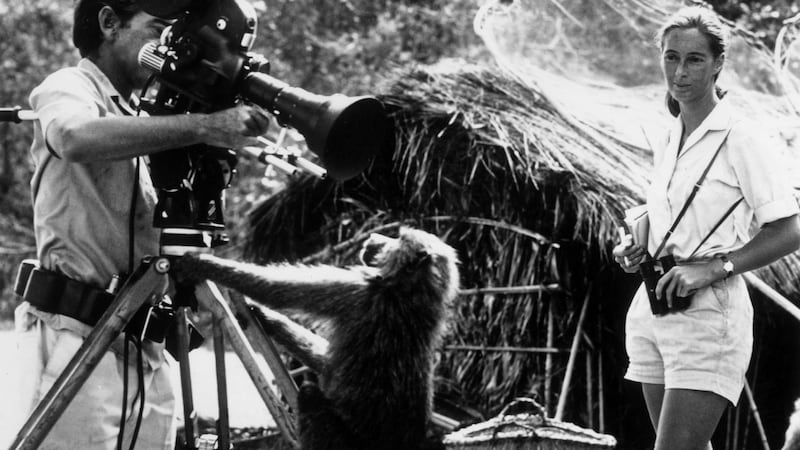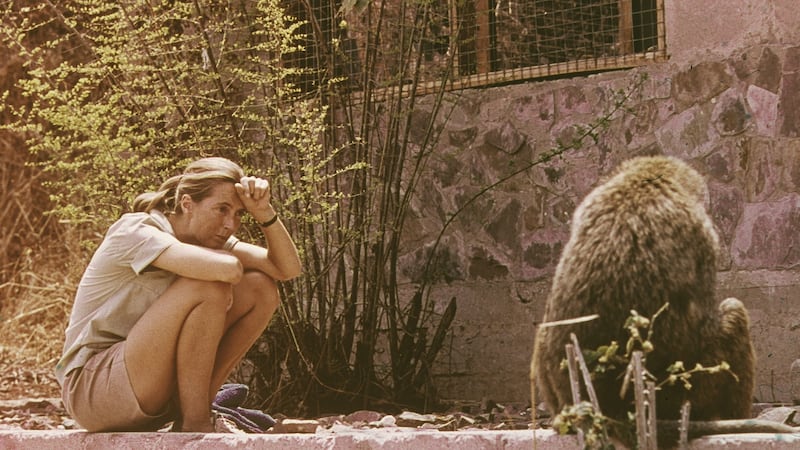As soon as Dr Jane Goodall steps out of the Jeep by the chimpanzee enclosure at the Uganda Wildlife Education Centre, there's a sudden outcry. The chimpanzees, previously quiet, begin to call loudly to each other, until the air is filled with their cries. The primatologist smiles.
Goodall is in Uganda to celebrate the 20th anniversary of the Ngamba Island chimpanzee sanctuary on Lake Victoria, set up by the Jane Goodall Institute to re-home chimpanzees orphaned or confiscated from traffickers and poachers, and is now home to 49 chimps, living on 95 acres of natural forest.
As part of the celebration, she names an orphaned chimpanzee, just under a year old, rescued in southwestern Uganda. As the frightened infant chimp is passed to her, he stares at the approaching crowd of journalists and photographers, firmly grips Goodall’s waist and refuses to let go.

It's almost 60 years since Goodall began her pioneering chimpanzee study in what is now Gombe National Park in Tanzania, and it's clear that her bond with the animals is as close as ever. She went to Gombe as a 26-year-old, with no college degree and no previous experience as a primatologist, but the results of her groundbreaking study into the behaviour of our closest animal relatives, guided by palaeontologist Louis Leakey, would lead her to be called "the woman who redefined man".
One of the defining moments was her observation of chimpanzees crafting rudimentary tools by stripping the leaves off a twig, and dipping it into a termite mound to fish out insects to eat.
“At that time, we humans were defined as ‘man the toolmaker’,” she says. “When Louis announced that I had seen chimpanzees using tools, now we had to redefine man, redefine tools, or accept chimpanzees as humans.”
Exploring the countryside
Growing up on the south coast of England, young Jane spent her days exploring the countryside with her dog, reading about Tarzan and the apes, and dreaming of a life in Africa, living amongst wild animals. Unable to afford university, she worked as a waitress until she saved up enough money to travel to Kenya and stay with friends, where she introduced herself to Leakey, by then a renowned palaeontologist .
He wanted somebody who was doing it simply because they were utterly fascinated and wanted to learn
He had wanted to set up a primate study, hoping that observation would shed light on the behaviour of our primitive ancestors, whose fossil remains he studied. Goodall became his secretary, and as he discovered her patience and her fearlessness faced with wild animals they encountered in his fieldwork, he proposed that she undertake the chimp study.
Goodall points out now that at the time, she didn’t have a degree. “He said, ‘That doesn’t matter’. He wanted a fresh mind,” she remembers. “He wanted somebody who was doing it simply because they were utterly fascinated and wanted to learn, and so it was magical.”
An acclaimed National Geographic documentary released in 2017 brings a new perspective to the extraordinary career of the young researcher from Bournemouth whose work overturned long-held beliefs about animal behaviour.
Jane, directed by Brett Morgen, is cut from more than 100 hours of intimate footage of Goodall living and working among the chimps in the Tanzanian rainforest. Considering it unacceptable for an Englishwoman to live alone in the bush, the British authorities insisted she bring a companion. Goodall, whose parents were divorced, chose her mother Vanne, who set up a small clinic where she dispensed medicine and basic treatment to locals, while her daughter spent from dawn until sunset alone in the bush, climbing up and down ravines, trying to get closer to the chimps.
The documentary shows the two women living in the rainforest, washing in streams, and documents how, inch by inch, month by month, Goodall gains the acceptance of her primate neighbours, while avoiding snakes and predators. Looking back now, Goodall laughs at the suggestion that this was brave.
“I never really felt that I was daring or anything”, she says. “Once I’d got the chimps used to me and I could enjoy the surroundings, then I found that being in the forest for me is the most spiritual experience on the planet, and you get a very strong feeling of the interconnectedness of living things. It’s really magical for me.”
Passion for animals
The footage in the film, lost for decades, was shot by Hugo van Lawick, a young Dutch photographer and filmmaker sent to document Goodall’s work for National Geographic, which had begun to fund her studies. Though the introverted Goodall was a little put out at first by the arrival of van Lawick in her jungle paradise, and by the trail of cigarette butts he left around their encampment, the two soon grew close. Van Lawick shared her passion for animals, and she says: “It was pretty obvious to me from the start that I was a subject of interest as well as the chimps.”

When the two left the jungle to spend Christmas at their respective homes, a cable arrived in Bournemouth for Goodall.
“WILL YOU MARRY ME STOP LOVE HUGO STOP”.
“YES STOP JANE,” came the reply.
The couple married, had a son, Hugo, nicknamed “Grub”, and returned to Tanzania.
As Goodall's fame grew with her discoveries, she encountered both sexism and academic criticism. Newspaper headlines described her as a "pert scientist" and squealed: "Young, Blonde and Beautiful…And a Scientific Whiz!" or "Comely Miss Spends Her Time Eyeing Apes". Her first important discoveries were severely criticised by academics.
“The stuffy old scientists said, ‘Well, she hasn’t even been to college, can’t believe a word she says!’” says Goodall. Leakey sent her to study at Cambridge in 1961, where she was one of very few students to be accepted as a PhD candidate without a degree.
Her studies also rankled due to what was seen as a scientifically damaging anthropomorphism: Goodall gave her chimp subjects names, rather than numbers. The first to let her approach him was David Greybeard, the top-ranking male, Goliath, and the females included Flo and her daughter, Fifi. At the time, only humans were thought to have personalities and to be capable of rational thought, but Goodall's unprecedented studies showed that the primates expressed emotions such as fear, jealousy and grief.
Her descriptions of thinking, feeling creatures, living and co-operating as a community, challenged the uniqueness of humanity. Her naming of the chimps also helped to spread public awareness of her work. When Flo died in 1972, the Times of London published an obituary.
Full-time activist
In 1986, Goodall became a full-time activist after attending a conference on chimp behaviour, which included a session on conservation. Appalled at the level of destruction of the chimpanzees' habitat due to deforestation, and their rapidly decreasing population, she undertook her mission to preserve their habitat, which continues today. "I went to that conference as a scientist planning to carry on, and I left as an activist. I didn't make a decision, I just was a different person," she says. She decided to study first hand the extent and the effects of habitat loss. Uganda was the first stop on her tour, and she continues to visit the Uganda Wildlife Education Centre in Entebbe, which she helped to turn into a suitable place to rehabilitate chimpanzees, and the Ngamba Island Chimp Sanctuary, founded by her institute, every couple of years.
At the Wildlife Education Centre, Goodall speaks to youngsters who are part of Roots and Shoots, a community action programme designed to teach youngsters about conservation and leadership, and, as she puts it, “to make sure the next generation are better stewards than we have been”.
The programme was a response to the reactions of young people she met in the course of her activism, who felt betrayed by their parents’ generation. “I was travelling around raising awareness and also trying to raise funds, and I met young people who seemed to have little hope for the future. Young people who were really depressed, really angry. Most of them just apathetic . . . ‘It doesn’t matter what we do, it’s hopeless . . . you’ve compromised our future and there’s nothing we can do about it’. We have compromised their future”, she says, “But I don’t believe it’s true there’s nothing that can be done.”
Roots and Shoots has now been running for 27 years and is present in more than 100 countries around the world.

Goodall’s activism for the chimpanzees and their habitat is becoming more urgent, with the encroachment of a rapidly growing human population across Africa, and the associated destruction of forests for timber, cash crops and charcoal, along with housing, infrastructure and grazing land.
Fifty years ago, it was estimated that more than one million chimpanzees lived in the wild. Today, that number has dropped by 80 per cent, mainly due to deforestation, and to a lesser extent, disease and poaching.
As they’re forced to live in smaller areas of forest, chimpanzee populations become more vulnerable to disease and genetic weaknesses, and are forced to compete with humans for food.
“I realised I couldn’t help the chimps unless we helped the people too,” says Goodall.
Her institute runs programmes to help human populations, often in desperate poverty, to live alongside the chimps. In Uganda, JGI runs a programme to prevent human-animal conflict due to chimps crop-raiding for food. For example, locals have been taught to plant chillies, unpalatable to primates, around the chimps’ habitat to discourage theft of crops grown for human consumption. The plants also provide an extra source of income.
Frustrated
Despite her energy and optimism, Goodall is frustrated by what she sees as the lack of political leadership on conservation issues. For a researcher who sees humans and their evolution in terms of millennia, this political shortsightedness is incomprehensible.
I don't think they've got the ability to imagine what this planet will be like if we continue to destroy the environment
“I am simply unable to understand some politicians – and they’re in many countries now – who don’t seem to care about the future for their children, our children,” she says. “I think they feel they’re so powerful and anyway they’re going to be dead. I don’t think they’ve got the ability to imagine what this planet will be like if we continue to destroy the environment . . . They’ve turned their back on all of this. They just want their own immediate gratification or the immediate gratification of their children . . . Even when a case is crystal clear, governments and industry will fight it and say we haven’t really proven it yet. To me it’s shocking.”
At the Uganda Wildlife Education Centre, Goodall speaks out against animal activists who lobby for zoos to be shut down, and highlights the importance of preserving humane semi-natural spaces such as UWEC, where rescued chimps, who have become habituated to humans, can live and breed in safety. Ronald Wako, head of the primate section at the centre, agrees. "A chimpanzee which is rescued from illegal traffickers, if you bring it out here, rehabilitate it…you can't just let it back in the wild. If you release it, it's just going to run into the hands of the poachers because it is habituated, it's used to people. That's why you see the chimpanzees are living in a family, in a group, because they're social animals . . . here they're able to express their natural social abilities."
Wako says Goodall's encouragement is vital to the next generation. "If we have people coming out strongly on their objectives in conservation like Jane Goodall, we the young people, the people who are going take over, we get encouraged, because if her work is being recognized all over the world that means even us, if we keep pushing, we have more Jane Goodalls, we can save the world."

















